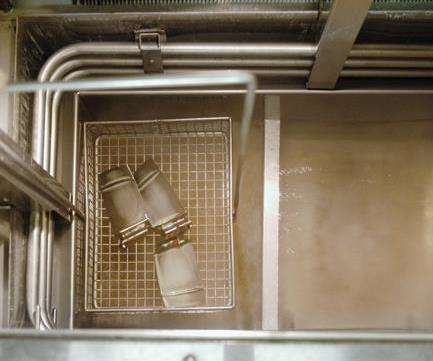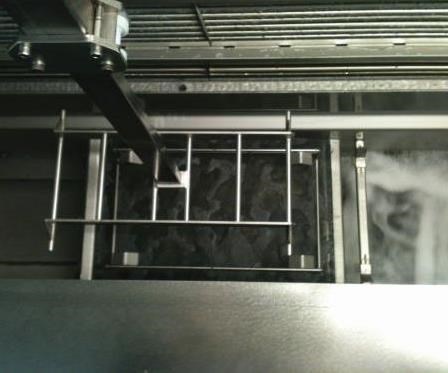Vapor Degreasing Fluid Meets Aerospace Application Requirements
The development of environmentally safe, yet effective solvents has kept vapor degreasing at the forefront of cleaning operations for metalworking.
Vapor degreasing is a popular cleaning process that has a long and storied past as the cleaning process of choice for providing parts free of contamination. Within the aerospace industry, vapor degreasing is a commonly used cleaning method because it is both simple and effective. Other high reliability industries, such as medical, electronics and automotive, also rely on this process to ensure the cleanliness of critical components.
The vapor degreasing cleaning process is both effective and convenient for the removal of metalworking fluids, cutting oils, corrosion inhibitors and waxes—soils that commonly remain after the manufacturing of parts at OEM and MRO (repair and overhaul) facilities. This process requires minimal floor space because parts can be cleaned and dried within the same cleaning chamber. Conversely, a typical aqueous immersion cleaning process comprising of one or more heated “soap” washing stages, followed by multiple heated rinsing and drying stages, could require three or more times the floor space. Another advantage of the vapor degreasing process is the significantly lower energy costs relative to the aqueous cleaning process alternative.
Featured Content
For many years, the solvent of choice for vapor degreasing was 1,1,1-trichloroethane (TCA). At the time of the implementation of the Montreal Protocol, the use of TCA as a vapor degreasing solvent was restricted because it was considered to be a major contributor to ozone depletion, along with many chlorofluorocarbons (CFCs). These restrictions severely limited the number of viable vapor degreasing solvent options available to process operators.
Subsequently, the U.S. Environmental Protection Agency (EPA) launched the Significant New Alternatives Program (SNAP). One of the solvents that was approved as a viable alternative to CFCs for the vapor degreasing process under the SNAP program was trichloroethylene (TCE). Soon after the approval of TCE, many vapor degreasing operators converted their vapor degreasing solvent to TCE. Over time, though, concerns associated with the use of TCE have arisen regarding its potential carcinogenicity and its classification as a hazardous air pollutant (HAP), so the search for other alternatives continued. In 2007, one such alternative, n-propyl bromide (nPB), was also approved under the SNAP program. nPB offered similar cleaning performance as TCE, but it was given a “non-regulated” status because it was not classified as a HAP, nor was it considered a potential carcinogen.
Recently, TCE has been deemed a human carcinogen by the U.S. EPA. In addition, the American Conference of Governmental Industrial Hygienists (ACGIH) has raised concerns about the potential health risks of exposure to nPB. The combination of the change in the classification of TCE and the concerns of the ACGIH with respect to nPB have given many OEM and MRO facilities reason to strongly consider alternative vapor degreasing solvents to TCE and nPB.
All of these concerns have led to the following questions: “Why do companies continue to use the vapor degreasing processes?” and “Why do they view vapor degreasing as the preferred cleaning process?”
Patrick Oliver, sales manager with vapor degreasing equipment manufacturer, Baron Blakeslee, offered his insight into this matter. “Our customers use vapor degreasing as the preferred cleaning process because it works better than any other cleaning method,” he says. “Our company offers aqueous cleaning equipment, too, so I do not want to denigrate that technology. It does have its place. In my opinion, the only reasons to use an aqueous process are if a soil is only soluble in water, if the aqueous process is necessary for materials compatibility (although there are solvent formulations that offer a range of materials compatibility), or in cases where a surface conversion process such as phosphating, etching or oxidizing is being performed.”
Customer Requirements
A major U.S.-based commercial airline employs a vapor degreasing process in a traditional open-top vapor degreaser to clean landing gear components from each aircraft during the FAA mandated “D Checks.” The company had reached a decision to replace both TCE and nPB, the vapor degreasing solvents currently in use, because of environmental and employee exposure concerns. Numerous requirements for the alternative solvent were identified:
- Broad compatibility with metallic alloys
- Non-flammable classification
- Non-carcinogenic
- Not considered a HAP
- SNAP approval as a vapor degreasing solvent
- Higher permissible exposure limits (PELs)
- Boeing BAC 5408 approval
- Equivalent or enhanced soil removal capabilities
Cleaning Product Evaluation
Petroferm, a supplier of specialty cleaning agents, directed the customer toward Lenium FHD, a hydrofluorocarbon-based vapor degreasing solvent that is designed to be used in open-top or vacuum vapor degreasing systems. This solvent can act as a drop-in replacement for TCE and nPB, as well as HCFC-141b, HCFC-225 and perchloroethylene (PERC).
The solvent leaves low surface residue and is safe for use with a range of metallic ferrous and nonferrous alloys, including aluminum, copper and copper alloys, magnesium, nickel, steel, stainless steel, titanium and zinc. It is also compatible with many polymeric substrates and elastomers. While this customer was particularly concerned with oil removal, the solvent is also capable of handling other soils such as adhesives, buffing compounds, corrosion inhibiting compounds, greases, hydraulic fluids, metalworking fluids and other particulate.
Especially important to this customer is that the solvent meets the Boeing BAC 5408 vapor degreasing specification, but it also conforms to Boeing D6-17487 and Douglas CSD #1 (except stress crazing on acrylics) and has been approved by Rolls-Royce OMat 1/21E vapor degreasing, Lockheed Martin EMAP G41.149, and Goodrich Power Systems mono-solvent vapor degreasing NO: 914-014-078 to 085.
This blend of SNAP-approved components is non-flammable and non-carcinogenic and is not considered a HAP. The VOC content is half that of TCE and nPB, and the recommended exposure limit of 200 ppm is also considerably higher than that of TCE and nPB. The solvent also has no ozone depleting potential.
| Vapor Degreasing Solvent | Vapor Blanket Temperature | Cleaning Process |
|---|---|---|
| n-Propyl Bromide | 160°F (68°C) | Coupons suspended in vapor blanket for 5 minutes |
| Lenium FHD | 99°F (37°C) | Coupons suspended in vapor blanket for 5 minutes |
Test Protocol and Component Preparation
The large size of the components and sensitive nature to which the parts must be handled made them impractical for use during the screening tests. Instead, a testing protocol was designed that used 1.5-inch-diameter 2024 aluminum alloy coupons as the metal substrate. The soils selected for the testing protocol were a number of commonly used aerospace oils. Each coupon was coated with an oil sample and allowed to “air dry” for a minimum of 24 hours at room temperature to “harden” the soil prior to cleaning.
The cleaning tests were performed in an open-top vapor degreaser using either nPB or Lenium FHD as the solvent (see Table 1). The soiled coupons were suspended in the solvent vapor blanket for 5 minutes, and then removed. Since all of the aerospace oils selected for the tests were known to fluoresce under ultraviolet light, it would be possible to detect trace amounts of residual oil on the coupons after cleaning.
Nine different oils were used during the tests, and in all cases, the results between the two solvents were equivalent. These results gave the customer confidence to install Lenium FHD in its existing vapor degreasing process, which has since exceeded customer expectations. The project is viewed as a complete success because the solvent has provided a safer work environment with low environmental impact while meeting the tough cleaning specifications.
— Vantage (formerly Petroferm)
RELATED CONTENT
-
Automated Cleaning System Improves Productivity
This rotary basket washer drastically reduced the number of operators tending to the cleaning process as well as removed the bottleneck from that station.
-
A Primer On Parts Washing—Here’s How To Get Your Parts Really Clean
Cleaning is loosely defined as the process of removing unwanted contaminants or dirt from a surface. It does not alter the surface physically or chemically. A properly cleaned surface is just the same as it was prior to cleaning, except it is missing the dirt.
-
The Best Technical Cleanliness Practices for ISO 16232
The aim is to assess and compare the technical cleanliness of parts produced by different manufacturers or at different locations.







